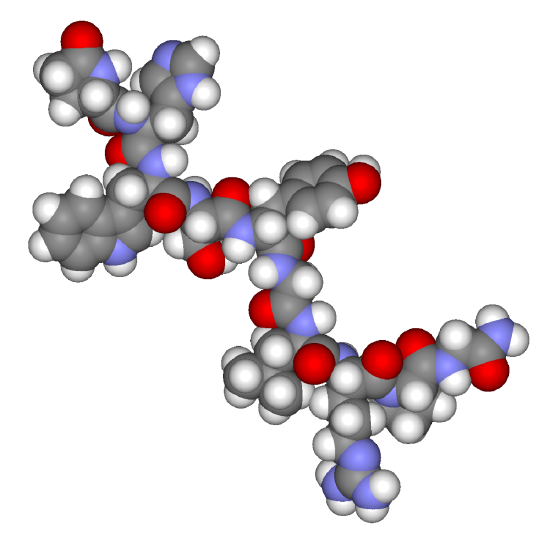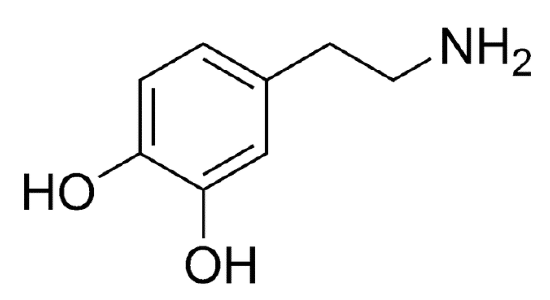15.6.1.5: Hormones of the Hypothalamus
- John W. Kimball
- Tufts University & Harvard
- Thyrotropin-releasing hormone (TRH)
- Gonadotropin-releasing hormone (GnRH)
- Growth hormone-releasing hormone (GHRH)
- Corticotropin-releasing hormone (CRH)
- Somatostatin
- Dopamine
All of these are released into the blood in the capillaries and travel immediately – in portal veins – to a second capillary bed in the anterior lobe of the pituitary, where they exert their effects. All of them are released in periodic spurts. In fact, replacement hormone therapy with these hormones does not work unless the replacements are also given in spurts. Two other hypothalamic hormones vasopressin and oxytocin travel in the neurons themselves to the posterior lobe of the pituitary where they are released into the circulation.
Thyrotropin-releasing hormone (TRH)
TRH is a tripeptide (GluHisPro). When it reaches the anterior lobe of the pituitary it stimulates the release there of thyroid-stimulating hormone (TSH) and prolactin (PRL)
Gonadotropin-releasing hormone (GnRH)
GnRH is a peptide of 10 amino acids. Its secretion at the onset of puberty triggers sexual development, and from then on it is essential for normal sexual physiology in both males and females. In both sexes, its secretion occurs in periodic pulses usually occurring every 1–2 hours.

Space-filling model of gonadotropin-releasing hormone. (public domain, Fvasconcellos).
| Primary Effects | Secondary Effects |
|---|---|
| FSH and LH Up | estrogen and progesterone Up (in females) |
| testosterone Up (in males) |
After puberty, a hyposecretion of GnRH may result from intense physical training or anorexia nervosa. Synthetic agonists of GnRH are used to treat inherited or acquired deficiencies of GnRH secretion and prostate cancer. In this case, continuous high levels of the GnRH agonist
- reduces the number of GnRH receptors in the pituitary, which
- reduces its secretion of FSH and LH, which
- reduces the secretion of testosterone, which
- reduces the stimulation of the cells of the prostate.
Growth hormone-releasing hormone (GHRH): GHRH is a mixture of two peptides, one containing 40 amino acids, the other 44. As its name indicates, GHRH stimulates cells in the anterior lobe of the pituitary to secrete growth hormone (GH).
Corticotropin-releasing hormone (CRH): CRH is a peptide of 41 amino acids. As its name indicates, its acts on cells in the anterior lobe of the pituitary to release adrenocorticotropic hormone (ACTH). CRH is also synthesized by the placenta and seems to determine the duration of pregnancy. It may also play a role in keeping the T cells of the mother from mounting an immune attack against the fetus.
Somatostatin: Somatostatin is a mixture of two peptides, one of 14 amino acids, the other of 28. Somatostatin acts on the anterior lobe of the pituitary to inhibit the release of growth hormone (GH) and inhibit the release of thyroid-stimulating hormone (TSH). Somatostatin is also secreted by cells in the pancreas and in the intestine where it inhibits the secretion of a variety of other hormones.
Dopamine
Dopamine is a derivative of the amino acid tyrosine. It mediates several functions in the brain, including inhibiting the release of prolactin (PRL) from the anterior lobe of the pituitary, modulating motor-control centers (a loss of dopamine-secreting cells produces Parkinson’s disease), and activating the reward centers of the brain. Dopamine-secreting cells are also found in other parts of the body where most of its actions are paracrine; that is, acting on nearby cells.

Vasopressin and Oxytocin
These peptides are released from the posterior lobe of the pituitary and are described in the page devoted to the pituitary.
This page titled 15.6.1.5: Hormones of the Hypothalamus is shared under a CC BY 3.0 license and was authored, remixed, and/or curated by John W. Kimball via source content that was edited to the style and standards of the LibreTexts platform; a detailed edit history is available upon request.
Recommended articles
- Article type Section or Page Author John W. Kimball License CC BY License Version 3.0 Show TOC no
- Tags
- Corticotropin-releasing hormone (CRH)
- dopamine
- Growth hormone-releasing hormone (GHRH)
- hypothalamus
- oxytocin
- prolactin
- somatostatin
- source@https://www.biology-pages.info/
- thyroid-stimulating hormone